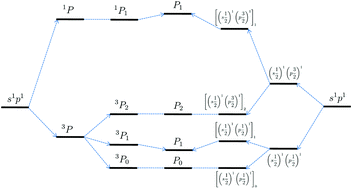当前位置:
X-MOL 学术
›
Chem. Soc. Rev.
›
论文详情
Our official English website, www.x-mol.net, welcomes your
feedback! (Note: you will need to create a separate account there.)
Relativistic time-dependent density functional theories
Chemical Society Reviews ( IF 40.4 ) Pub Date : 2018-05-29 00:00:00 , DOI: 10.1039/c8cs00175h Wenjian Liu 1, 2, 3, 4, 5 , Yunlong Xiao 1, 2, 3, 4, 5
Chemical Society Reviews ( IF 40.4 ) Pub Date : 2018-05-29 00:00:00 , DOI: 10.1039/c8cs00175h Wenjian Liu 1, 2, 3, 4, 5 , Yunlong Xiao 1, 2, 3, 4, 5
Affiliation

|
The foundations, formalisms, technicalities, and practicalities of relativistic time-dependent density functional theories (R-TD-DFT) for spinor excited states of molecular systems containing heavy elements are critically reviewed. These include the four-component (4C) and exact two-component (X2C) variants (4C/X2C-TD-DFT) that treat both scalar relativistic effects and spin–orbit couplings (SOC) to infinite order, and a composite two-component variant (sf-X2C-S-TD-DFT-SOC) that treats scalar relativistic effects to infinite order via the spin-free part of the X2C Hamiltonian (sf-X2C) but SOC to first order via the Douglas–Kroll–Hess type of spin–orbit operator resulting also from the spin separation of the X2C Hamiltonian. Except for the common adiabatic approximation, the most essential ingredient for all the three variants of R-TD-DFT is the noncollinear exchange–correlation kernel that is invariant with respect to rotations in spin space. It is unfortunate that 4C- and X2C-TD-DFT cannot be made fully symmetry adapted for open-shell systems except for some special cases. Yet, this is possible for closed-shell systems by working with both double point group and time reversal adapted molecular spinors. In particular, the spinor Hessian can be made real-valued in this case, such that the 4C/X2C-TD-DFT eigenvalue problems can be solved in the same manner as nonrelativistic TD-DFT, a point that is discovered here for the first time. By contrast, sf-X2C-S-TD-DFT-SOC can access spinor excited states of both closed- and open-shell systems because spin symmetry is fully accounted for in the spin-adapted TD-DFT (S-TD-DFT). Possible further developments of R-TD-DFT are also highlighted.
中文翻译:

相对论的时变密度泛函理论
严格审查了相对论随时间变化的密度泛函理论(R-TD-DFT)的含重元素的分子系统的自旋激发态的基础,形式主义,技术性和实用性。其中包括四分量(4C)和精确的二分量(X2C)变体(4C / X2C-TD-DFT),它们将标量相对论效应和自旋轨道耦合(SOC)都处理为无穷大,并且还有两个组件变体(sf-X2C-S-TD-DFT-SOC),它通过X2C哈密顿量(sf-X2C)的无自旋部分将标量相对论效应处理为无穷大,而SOC通过X2C哈密顿量的自旋分离也产生了道格拉斯—克罗尔—海斯类型的自旋轨道算子。除了常见的绝热近似,R-TD-DFT的所有三个变体中最重要的成分是非共线交换-相关核,该核对于自旋空间中的旋转是不变的。不幸的是,除某些特殊情况外,不能使4C和X2C-TD-DFT完全对称地适用于开壳系统。然而,对于封闭壳系统,通过与双点群和时间逆转适应的分子旋转子一起工作,这是可能的。特别是在这种情况下,可以使自旋Hessian成为实值,从而可以以与非相对论TD-DFT相同的方式来解决4C / X2C-TD-DFT特征值问题,这是本文首先发现的一个问题。时间。相比之下,sf-X2C-S-TD-DFT-SOC可以访问闭壳和开壳系统的自旋激发态,因为自旋适应性TD-DFT(S-TD-DFT)中充分考虑了自旋对称性。还重点介绍了R-TD-DFT可能的进一步发展。
更新日期:2018-05-29
中文翻译:

相对论的时变密度泛函理论
严格审查了相对论随时间变化的密度泛函理论(R-TD-DFT)的含重元素的分子系统的自旋激发态的基础,形式主义,技术性和实用性。其中包括四分量(4C)和精确的二分量(X2C)变体(4C / X2C-TD-DFT),它们将标量相对论效应和自旋轨道耦合(SOC)都处理为无穷大,并且还有两个组件变体(sf-X2C-S-TD-DFT-SOC),它通过X2C哈密顿量(sf-X2C)的无自旋部分将标量相对论效应处理为无穷大,而SOC通过X2C哈密顿量的自旋分离也产生了道格拉斯—克罗尔—海斯类型的自旋轨道算子。除了常见的绝热近似,R-TD-DFT的所有三个变体中最重要的成分是非共线交换-相关核,该核对于自旋空间中的旋转是不变的。不幸的是,除某些特殊情况外,不能使4C和X2C-TD-DFT完全对称地适用于开壳系统。然而,对于封闭壳系统,通过与双点群和时间逆转适应的分子旋转子一起工作,这是可能的。特别是在这种情况下,可以使自旋Hessian成为实值,从而可以以与非相对论TD-DFT相同的方式来解决4C / X2C-TD-DFT特征值问题,这是本文首先发现的一个问题。时间。相比之下,sf-X2C-S-TD-DFT-SOC可以访问闭壳和开壳系统的自旋激发态,因为自旋适应性TD-DFT(S-TD-DFT)中充分考虑了自旋对称性。还重点介绍了R-TD-DFT可能的进一步发展。











































 京公网安备 11010802027423号
京公网安备 11010802027423号